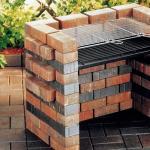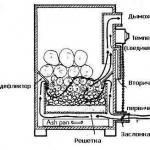How to coat wood with malachite. Imitation of the surface of natural stones on products in decoupage and other creativity. Simulation method for layered rocks
We will need:
Cardboard box (or wooden box blank)
White acrylic paint
Green acrylic paint
A napkin with a pattern or a printed photograph.
Stencil
Acrylic varnish
A small piece of cotton fabric
Cover the workpiece with acrylic paint. You can use a roller, or you can use a sponge or brush. Whichever is more convenient for you.


Then, take a small piece of cloth, moisten it in water, squeeze it well in your fist so that the cloth turns out crumpled and with folds. Place it on the painted surface (until the paint has dried) and roll it over it with a cloth. Then, take a small piece of cloth, moisten it in water, squeeze it well, clenching it in your fist, so that the cloth turns out crumpled and with folds. Place it on the painted surface (until the paint has dried) and roll it over it with a cloth.


We do this with the entire box. This is what we got.

The inside of the box was painted a soft light green color. I made a pattern using a stencil.

Take a printed photo:

We cover it with 3-4 layers of acrylic varnish. Next, soak in warm water for half an hour and carefully separate the layer with the pattern from the layer with paper.
Glue the design to the lid and make a frame around it

Dear readers, if you want to learn how to imitate malachite, then take a look at this page, which shows and tells in detail how to do this imitation malachite with his own hand.
Imitating malachite is not so difficult, but you should always have a sample in front of your eyes that you will imitate. For this, the Internet will help us, from which I posted here a photo depicting natural malachite.






If you noticed, malachite consists of veins of a greenish-turquoise hue with different saturations. These veins form all sorts of chaotic curls, which we will learn how to create on the surface to be decorated, which must first be primed, and if the surface is wooden, then the surface must be sanded beforehand. To achieve a smooth surface, after the primer has dried, sand it with sandpaper and cover it with a very light malachite shade.

When the light malachite shade has dried, cover it with acrylic varnish and dry the surface. So far, all this was a preliminary stage of imitation of malachite.
Now comes the most interesting main stage of the simulation
Mix the paint with a more saturated malachite color and add a couple of drops of black for depth. If you have a medium for acrylic or glisal, then we dilute the paint with these means. If you don’t have this product available, which slows down drying and makes the paint more viscous and transparent, then replace it with washing gel, which, like the first products, will slow down the drying of the paint, which means we will have time to properly twirl over it with a homemade sponge made of twisted corrugated paper.
We first apply our malachite mixture with a wide brush and immediately begin smoothing this layer with screw movements, as shown in the picture.
During these creative manipulations, we spy on the sample with one eye. which one you choose as a role model :)

That's all the imitation, which runs very quickly and looks bright and rich :)
Successful experiments with homemade malachite imitation with your own hands :)
A small digression: Comfortable sleep is very important for a person, since during sleep the entire body is restored, so a comfortable bed plays a huge role for your health and sweet sleep, the service life of which for many has clearly already expired. Today, even a bed can be purchased in an online store with home delivery - an excellent convenient service! Let me make your search easier and offer you a wonderful online store posted on the website smsmebel.ru, in which you can choose comfortable beds for yourself inexpensively in Moscow from the huge assortment offered by the online store and your body will thank you very much as soon as the bed you have chosen is delivered directly to your home :)) Sweet dreams to you and excellent recovery of all your body :)
Time to make stones!
The combination of an image, metal fittings and a bright, fancy structure of minerals on an object always looks very impressive. Using a small set of acrylic paints and household materials, you can turn a surface of any shape into “stone”.
The pattern on the surfaces of stones can be roughly divided into groups:
Layered,
spotted,
Thread.
For example, malachite is layered, but granite and lapis lazuli are spotted, etc.



1. Cover your work surface. Put on an apron or overalls (if acrylic paint gets on the fabric it is difficult to remove later), prepare several containers with clean water.
2. Select synthetic brushes: wide flat and round with long bristles (for ease of work, it’s good to have brushes of different sizes on hand).
3. Prepare pieces of a dish sponge, a sea sponge (not necessarily a natural one, an imitation of it can be successfully used), scissors, a toothbrush, napkins, and rags. You will also need fine-grit sandpaper.
4. Select photographs of the stone and a set of paints required in advance.
6. Multi-layer varnishing makes the imitation of a stone surface more natural, so no matter what method and stone you choose, try not to neglect this stage.
Simulation method for layered rocks
Imitation of malachite in decoupage using acrylic paint
Let's look at the example of malachite.
Malachite is a mineral that forms green sinter-shaped masses with a radial fibrous structure.
Light green, dark cobalt green, heavenly, whitewash, ultramarine, natural umber, black.
Additional materials:
Additional materials:
Additional materials:
From the tools:
Sea sponge;
Additional materials:
From the tools:
Sea sponge;
The palette is plastic.
1. Background. On the palette, mix a small amount of Kaput mortuum with white. We get a pleasant delicate pink color. There is no need to mix the paints thoroughly, leaving the color uneven.

Using a wide synthetic brush, apply a thick layer of paint to the surface of the workpiece, creating smooth transitions.

2. Stains. We wet the sponge in clean water, wring it out, put a small amount of white on it and make impressions, lightly touching the surface.

We fill the workpiece area only partially in this way, about a third. The direction of the applied light paint will serve as the basis for drawing future veins.

3. Veins. Apply Kaput Mortuum paint to a small round brush. Pre-wet the brush generously with water. The consistency of the paint should not be thick.

With a trembling hand and with varying pressure on the brush, we apply a vein and immediately blur its edge with water. We stretch the paint. We finalize the line with lighter translucent shades, paint with the addition of white and well diluted with water.

In the same way we draw all the other lines, including light gray ones.


4. We work again with a sponge with a light color applied to it.

5. Drying and varnishing. We cover the surface with several layers of acrylic varnish, dry it, and level the surface with fine-grained sandpaper. We repeat the operation, gradually diluting the varnish with water. For effectiveness, we recommend applying at least 20 layers of acrylic gloss varnish.


Imitation pink marble is ready.

3. Stains. Dip the sponge into water and squeeze out. Apply Ultramarine to it and walk over the entire surface.

Repeat the operation with Cobalt Blue.

4. Veins. Using a thin round brush, apply whitewash to curved lines and blur their edges with water until the paint has dried.

5. Spray. Use a brush or toothbrush to take white paint diluted with water and spray it over the surface.

Do the same with applying gold paint.

6. Drying and varnishing. We cover the surface with several layers of acrylic varnish, dry it, then level the surface with fine-grained sandpaper.

We repeat the operation, gradually diluting the varnish with water and reducing the grain size of the sandpaper. For effectiveness, we recommend applying at least 20 layers of acrylic gloss varnish.

And we complete the process with finishing varnish.

The “lapis lazuli” surface is complete.

Imitation of turquoise using monotype technique
Turquoise is an ornamental and semi-precious stone, a mineral popular from ancient times to the present day. Creating a background for the veins and natural spots of this stone deserves special attention.
Colors of paints from the palette of artistic paints "Acrylic Art": Turquoise, Cobalt blue, White,
The demand for malachite is explained by the beauty of this stone. The color of malachite can vary from light turquoise shades to rich, deep dark green tones. The texture is extremely varied. There are stones with layers of different colors; there may be alternating layers in the form of ribbons, circles, stripes. The most valuable stone is one that has thin concentric rings in its depth in the shape of a peacock's eye.
It attracts attention overnight, so every connoisseur of natural materials wants to be the happy owner of jewelry made from this stone. With the growing popularity of the mineral, its natural sources became depleted, so methods for the synthesis of malachite were developed. There are also counterfeits of stone, which are made from ceramics, glass, and plastic. Of course, the cost of such a product is significantly lower than a product made from natural stone.
Malachite: capabilities and features
The mineral is best worn by people seeking fame. Malachite has the ability to attract increased attention and develop wisdom. When trying to understand the darkness of your own soul natural malachite– the best way to discover prospects for development.
The stone is well suited for children as an amulet. Such a talisman stimulates curiosity and pacifies restlessness. For a child, you should choose a mineral with a delicate shade of the first spring greens. The texture should have curls.
The properties of malachite jewelry allow you to quickly resolve all life situations, so this stone is indispensable for an active pace of life. The mineral is most suitable for Taurus and Libra, but Leos can also use it. But Virgos and Scorpios should not wear malachite.
The stone is quite delicate. It should not be subjected to temperature changes or shock. Cleaning with abrasives, steam or ultrasound is not permitted. You can only use regular soap solution.
Natural stone and fake. How to distinguish?
To make it look more like a real stone, manufacturers can resort to some tricks. In order to enhance the color and get rid of small cracks, a special impregnation of the product with paraffin or resin is used. It will not be difficult to determine the implementation of such a procedure in a special laboratory. To identify a fake, you need to pay attention to several factors:
1. Color. Cheap imitation malachite does not have color differences in the thickness of the stone. Typically, a fake is distinguished by its uniform color and the absolute absence of any inclusions.
2. Shine. Synthetic products always have inclusions with a somewhat dirty tint, and the natural shine is completely absent. Imitation malachite is usually dull with brownish inclusions.
3. Chemical reaction. Malachite is characterized by a change in the color of the mineral at the point of contact with ammonia. This process will produce a blue color on the stone. If the product is made of artificial components, then the reaction will not occur. Whether this method should be used on real malachite is a controversial issue, especially considering the cost of the jewelry.
4. Hardness. If you run a knife or glass across malachite, the real mineral will be scratched and shavings will appear. There will be no scratch on the glass, but a whitish strip with a broken middle will remain on the plastic.
5. Heat treatment. A malachite bead, if held over an open fire, will change color. In the case when the product is made of glass, soot is formed without visible combustion. The plastic will catch fire and immediately begin to melt.
As can be seen, the methods how to distinguish malachite from fake stone, there are quite a lot and not all of them are safe for real mineral. The last way to find a truly worthwhile product is to contact a special laboratory and conduct a thorough analysis of the product. Of course, you should only look for valuable malachite jewelry in stores with a time-tested reputation. Then the purchase will only bring joy and eliminate doubts about your own uniqueness.
Imitation of malachite stone. Master class on decoupage.
I am glad to welcome you! The second mini lesson from the mini course "Imitation of a stone surface."
I invite you to a malachite fairy tale!
I present to your attention part of the mini lesson.
There is a dream and there is a great desire to create
and create miracles with your own hands.
The craftswomen have prepared thoroughly, everything should be at hand.
Necessary materials:
- Preparing a cutting board (you can choose a box, jar, etc.)
- Acrylic paints: white, black, green paint in 3 shades.
- Water in a glass.
- Drying retardant for acrylic paint.
- Brushes, sponge or foam rubber, cardboard, sheets of paper.
- Acrylic lacquer.
- Sandpaper No. 400, 800, 2000.
- Decoupage card with motif.
- Great mood and desire to create.
The needlewomen took care of the household chores, fed the children and husband, cleaned the house and began working on magic. I am sure that you have also prepared everything and we will begin to work miracles. We will make a key holder from a simple plywood blank.
Let's first prepare the workpiece for work. Do you remember how a tree needs to be prepared for work? Well done!!!
Gently mix white and green paint with a palette knife. This is the base layer of our background.
With light movements using foam rubber, cover the entire workpiece with a thin layer. Let it dry, sand it with sandpaper and varnish it.
Let's prepare darker green paint and a plastic bag. Paint was applied to the surface with strokes and pressed once with a crumpled bag.
We also apply paint to the already prepared spots using strokes.
This is the result our needlewoman got. If you like it, then fix it with varnish.
Take a small cardboard and tear off the edge. Now the main thing is to work smoothly and quickly. Mix paints with a drying retardant. It turned out 4 colors.
Apply strokes, alternating light and dark tones of green. We apply the uneven side of the cardboard to the edge, lightly pressing only the bottom, and draw a semicircle in one direction.
This is what should happen in the end. You are satisfied with the result, then fix it with varnish.
After complete drying, apply a highly diluted mixture of light green and black. In some places, wipe off the paint with a napkin so that the main design clearly appears.
All that remains is to glue a small blank with an image, attach a hook, and decorate it with stickers or outlines.
The craftswoman made a wonderful stone. And you will be able to imitate malachite. The main thing is the desire to create and you will get your own unique pattern.
Who liked this tale about malachite, I invite you to subscribe to
Course “Imitation of a stone surface” 8 mini-lessons.
You will learn about the intricacies and secrets of various stone imitation techniques using simple and affordable materials.
Let's create unique decorative items together.






